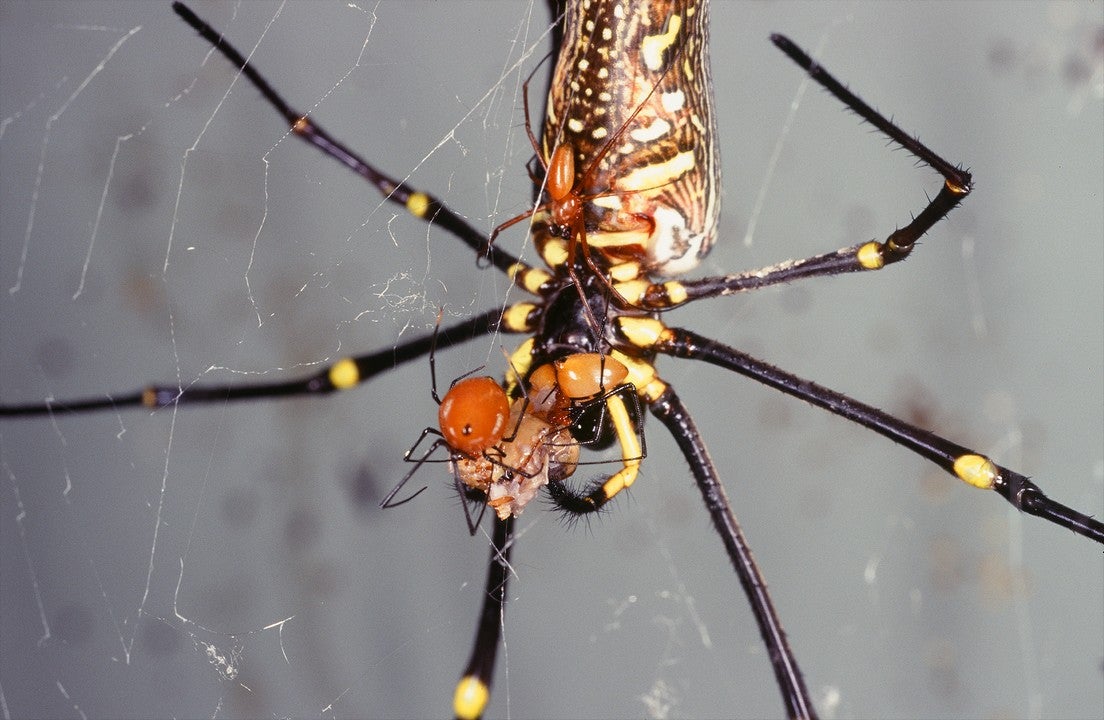When at risk of female cannibalism, male spiders select the paired sexual organ containing more sperm
August 16, 2022NUS biologists have discovered that male spiders make choices on maximising their mating success when they are at risk of being cannibalised by their female mates.
When sexual conflict results in reproductive strategies that only benefit one of the sexes, it may result in evolutionary arms races. Female sexual cannibalism in which an animal, usually the female, cannibalises its mate as part of the copulation process, is an extreme manifestation of sexual conflict. Male spiders have evolved behavioural mating strategies to improve their chances of mating despite the risk of being cannibalised by their mates. Among the various strategies observed, there seem to be more examples of behavioural strategies that augment male reproductive success and paternity. These include mate guarding, mate binding, opportunistic mating, sacrificial death during copulation, and genital mutilation, even emasculation.
In this study, Associate Professor LI Daiqin from Department of Biological Sciences, National University of Singapore, and his colleagues explore whether male spiders use additional cannibalism countering strategies by focusing on two male mating tactics. The “better charged palp” hypothesis predicts that male spiders selectively make use of the paired sexual organ (palp) containing more sperm for their first copulation; and the “fast sperm transfer” hypothesis predicts accelerated insemination when the risk of female cannibalism is high. The researchers performed comparative tests on five species of orb-web spiders from Singapore with varying levels of female sexual cannibalism and sexual size dimorphism. They found that a male chooses one of the paired sexual organs with more sperm for the first copulation with a cannibalistic female. Also, a male transfers significantly more sperm if a female is cannibalistic or when the female is of a much larger physical size. Their results support both the predictions from the better charged palp and the fast sperm transfer hypotheses, providing credibility for the male mating syndrome.
The outcome also opens new research questions on the ability of a male spider to differentiate the sperm quantities between his palps and also on the mechanisms involved in the palp selection after assessing his cannibalistic partner. By conducting follow-up experiments on Nephilengys malabarensis, a spider species exhibiting sexual cannibalism, the researchers have revealed that it is sperm volume detection, rather than left-right palp dominance, that plays a prominent role in the selection of the male palp.
Prof Li said, “This study sheds light on how male mating syndrome relates to the levels of sexual cannibalism and suggests that evolutionary arms races do take place, and that animal biology and diversity are importantly shaped by sexual conflict.”
Even as the researchers sought to understand the copulatory behaviour of male spiders in this study, future research is encouraged to better understand the rationale behind male palp choice. Assuming that volume detection is the fundamental mechanism for palp selection in orb-weaving spiders, the anatomical, neuronal and hormonal aspects of male palp choice may be explored to further understand how a male spider distinguishes relatively minute differences in sperm volumes.
“The large diversity of extant spiders globally indicates that these findings may not apply to all sexually dimorphic and cannibalistic spiders. Due to sexual selection, the palpal anatomy can undergo rapid changes, such that mechanisms behind sperm transfer of various species may differ,” added Prof Li.

Male Nephila pilipes spider copulating with a female mate. [Credit: Li Daiqin]
Reference
Zhang S; Yu L; Tan M; NYL Tan; XXB Wong; M Kuntner*; D Li*, “Male mating strategies to counter sexual conflict in spiders” COMMUNICATIONS BIOLOGY 5, 534 DOI:10.1038/s42003-022-03512-8 Published: 2022.


